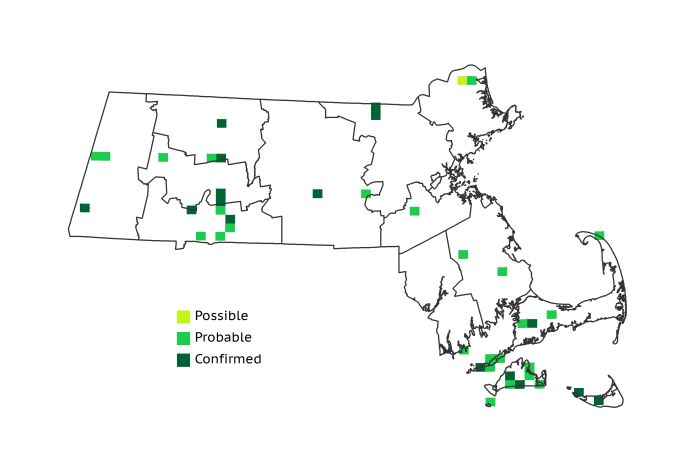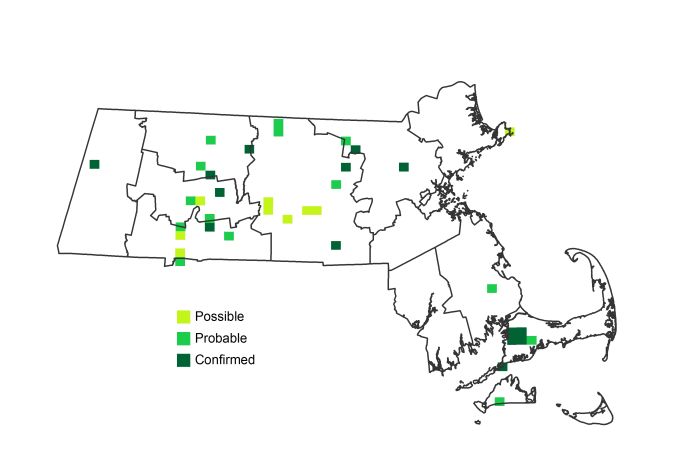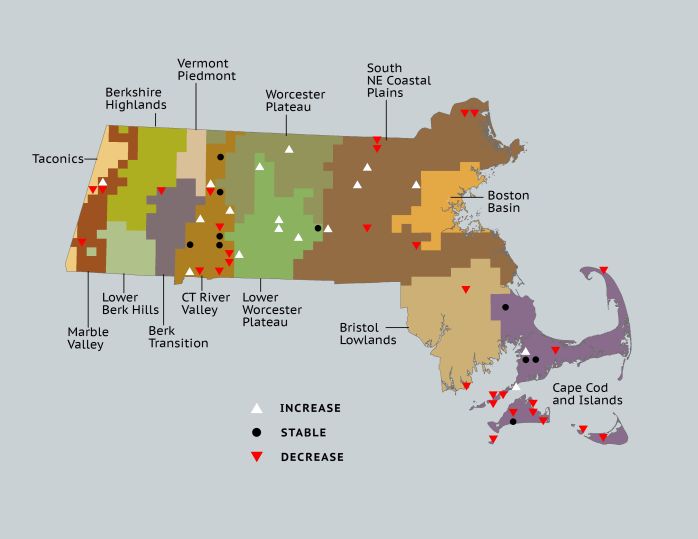Find a Bird
Grasshopper Sparrow
Ammodramus savannarum

Local and likely declining
Action/monitoring needed
Threatened Species
“It alights on the tops of low bushes, fence-rails, and tall grasses, to sing its unmusical ditty, composed of a few notes weakly enunciated at intervals, but sufficing to manifest its attachment to its mate.” – John James Audubon, Birds of America
The Grasshopper Sparrow is so named because of the acoustic properties of its dry, buzzy song, which resembles that of its namesake insect. The effect is quite good, and, when walking through a grassy field, a casual listener can have difficulty knowing whether the vocalization emanates from a sparrow or a grasshopper. Grassy, weedy fields are a precious resource in modern Massachusetts, and contemporary populations of this small, drab sparrow are struggling to avoid extirpation. Today the species is mostly found on conservation land or at large managed grasslands such as airports or reclaimed landfills.
Historic Status
The historical presence of the Yellow-shouldered or Yellow-winged Sparrow (as the Grasshopper Sparrow was once known) is difficult to ascertain. At the dawn of the twentieth century, Reginald Heber Howe and Glover Morrill Allen described the Grasshopper Sparrow as “a not uncommon local summer resident, but easily overlooked” (Howe & Allen 1901). Edward Howe Forbush reiterated this thought through his various publications in the first three decades of the twentieth century, noting that the song of the Grasshopper Sparrow was so thin and insect-like it could be missed even at relatively short distances (Forbush 1929). Whatever the case, as the state became increasingly reforested through the twentieth century, the species apparently lost the battle for suitable habitat, and gradually became even more difficult to detect as it continued to decline.
Atlas 1 Distribution
Like many obligate grassland-nesting species, Grasshopper Sparrows could be found only sparingly in Atlas 1, and statewide were located in only 42 blocks. Two blocks in the Marble Valleys and 1 in the Berkshire Transition were paltry totals next to the totals from the agricultural paradise of the Connecticut River Valley, from whence more than 26% of the Grasshopper Sparrow’s statewide range was housed. Atlas work conducted elsewhere in the state seldom found Grasshopper Sparrows in more than 1 or 2 blocks at a time, save for in the Cape and Islands. This region represented the true refuge of the Grasshopper Sparrow, especially the offshore Islands. Nashawena Island in the Elizabeth Islands chain hosted a notable concentration of breeding Grasshopper Sparrows, and both Nantucket and Martha’s Vineyard maintained their historical roles as havens for the species.
Atlas 2 Distribution and Change
Sadly, the disappearance of this grassland sparrow continued into Atlas 2. The fact that the Grasshopper Sparrow distribution fell to 37 blocks in Atlas 2, despite the species being protected as a Threatened Species in the state, is troubling. Breeding Confirmations went from 16 blocks in Atlas 1 to 14 in Atlas 2. The Lower Worcester Plateau showed an interesting increase of 5 new records where previously there had been 1, but the formerly sparrow-rich Connecticut River Valley showed a decrease in occupied blocks. Grasshopper Sparrows could not be found on Nantucket, and on Martha's Vineyard the species was reduced to a single record. The Massachusetts Military Reservation and environs proved to be the safest haven for Grasshopper Sparrows in the southeastern corner of the state. Bristol and Plymouth Counties supported only a single Probable nesting pair. The overall decline of the Grasshopper Sparrow was clearly a call to action for grassland obligate nesting species in the future.
Atlas 1 Map

Atlas 2 Map

Atlas Change Map

Ecoregion Data
Atlas 1 | Atlas 2 | Change | ||||||
Ecoregion | # Blocks | % Blocks | % of Range | # Blocks | % Blocks | % of Range | Change in # Blocks | Change in % Blocks |
Taconic Mountains | 1 | 6.3 | 2.4 | 0 | 0.0 | 0.0 | -1 | -6.7 |
Marble Valleys/Housatonic Valley | 2 | 5.1 | 4.8 | 1 | 2.6 | 2.7 | -1 | -2.6 |
Berkshire Highlands | 0 | 0.0 | 0.0 | 0 | 0.0 | 0.0 | 0 | 0.0 |
Lower Berkshire Hills | 0 | 0.0 | 0.0 | 0 | 0.0 | 0.0 | 0 | 0.0 |
Vermont Piedmont | 0 | 0.0 | 0.0 | 0 | 0.0 | 0.0 | 0 | 0.0 |
Berkshire Transition | 1 | 2.6 | 2.4 | 0 | 0.0 | 0.0 | -1 | -3.2 |
Connecticut River Valley | 11 | 19.6 | 26.2 | 12 | 18.5 | 32.4 | -2 | -4.2 |
Worcester Plateau | 0 | 0.0 | 0.0 | 2 | 2.3 | 5.4 | 1 | 2.1 |
Lower Worcester Plateau | 1 | 1.4 | 2.4 | 6 | 7.5 | 16.2 | 5 | 9.3 |
S. New England Coastal Plains and Hills | 6 | 2.2 | 14.3 | 8 | 2.8 | 21.6 | -2 | -0.9 |
Boston Basin | 0 | 0.0 | 0.0 | 0 | 0.0 | 0.0 | 0 | 0.0 |
Bristol and Narragansett Lowlands | 2 | 1.9 | 4.8 | 0 | 0.0 | 0.0 | -2 | -2.0 |
Cape Cod and Islands | 18 | 13.2 | 42.9 | 8 | 5.6 | 21.6 | -10 | -8.3 |
Statewide Total | 42 | 4.3 | 100.0 | 37 | 3.6 | 100.0 | -13 | -1.6 |
Notes
In accordance with Atlas decreases in distribution, Grasshopper Sparrows show significant decreasing Breeding Bird Survey trends in the New England/Mid-Atlantic Region and in the Eastern US overall.



